Element Migration of Mineralization-Alteration Zones and Its Geological Implication in the Beiya Porphyry–Skarn Deposit, Northwestern Yunnan, China
Abstract
:1. Introduction
2. Regional and Deposit Geology
3. Samples Selected and Analytical Methods
4. Result
4.1. Alteration Types
4.1.1. Porphyry Alteration
Potassic Alteration
Phyllic Alteration
Propylitic Alteration
Argillic Alteration
4.1.2. Contact Alteration
4.1.3. Wall-Rock Alteration
4.2. Mineralization Types
4.3. Mineralization and Alteration Zone
4.3.1. C1 Section
4.3.2. C2 Section
4.3.3. C6 Section
4.4. Geochemical Characteristics of Mineralization and Alteration Zone
4.5. Element Migration of Mineralization and Alteration Zone
5. Discussion
5.1. Regularity of Mineralization and Alteration Zoning
5.2. Mechanism of the Mineralization-Alteration Zone
5.3. Geological Implication of Element Migration for the Beiya Deposit
6. Conclusions
- (1)
- Three types of porphyry alteration, contact alteration, and wall-rock alteration are developed; and the porphyry alteration comprises four alteration zones of potassic, phyllic, propylitic, and argillic.
- (2)
- Five types of mineralization with various occurrence characteristics and distinctive metallogenic element associations are dominantly controlled by structures and lithologies.
- (3)
- Concentric-banded mineralization-alteration zones occur centrally from alkaline porphyry outward or upward, presenting common alteration zones of potassic → phyllic → propylitic → argillic → skarn alteration → wall-rock alteration, accompanying with individual elements gains and losses in different zones.
- (4)
- An inferred mineralization and alteration zoning model indicates the Beiya deposit is similar to the typical porphyry copper systems, and it also deepens the understanding of metallogenic regularity and provides scientific information for prospecting at Beiya, as well as at the same type of deposits in the Sanjiang metallogenic belt and elsewhere worldwide.
Author Contributions
Funding
Institutional Review Board Statement
Informed Consent Statement
Data Availability Statement
Conflicts of Interest
References
- Richards, J.P. Tectono-magmatic precursors for porphyry Cu-(Mo-Au) deposit formation. Econ. Geol. 2003, 98, 1515–1533. [Google Scholar] [CrossRef]
- Sillitoe, R.H. Porphyry copper systems. Econ. Geol. 2010, 105, 3–41. [Google Scholar] [CrossRef]
- John, D.A.; Taylor, R.D. By-products of porphyry copper and molybdenum deposits. In Rare Earth and Critical Elements in Ore Deposits; Verplanck, P.L., Hitzman, M.W., Eds.; Society of Economic Geologists, Inc.: Littleton, CO, USA, 2016; Volume 18, pp. 137–164. [Google Scholar]
- Tosdal, R.M.; Richards, J.P. Magmatic and structural controls on the development of porphyry Cu ± Mo ± Au deposits. Soc. Econ. Geol. Rev. 2001, 14, 157–181. [Google Scholar]
- Piquer, J.; Sanchez-Alfaro, P.; Pérez-Flores, P. A new model for the optimal structural context for giant porphyry copper deposit formation. Geology 2021, 49, 597–601. [Google Scholar] [CrossRef]
- Lowell, J.D.; Guilbert, J.M. Lateral and vertical alteration-mineralization zone in porphyry ore deposits. Econ. Geol. 1970, 65, 373–408. [Google Scholar] [CrossRef]
- Hollister, V.F.; Potter, R.R.; Barker, A.L. Pophyry-type depositt of Appalachian Orngen. Econ. Geol. 1974, 69, 618–630. [Google Scholar] [CrossRef]
- Hollister, V.F. Models for prospect eraluation of porphyry copper deposits. In Porphyry Copper, Molybdenum, and Gold Deposit, Volcanogenic Deposits (Massive Sulfides), and Depositsin Layered Rock; Hollister, V.F., Ed.; Society for Mining, Metallurgy and Exploration: New York, NY, USA, 1991; Volume 3, p. 5210. [Google Scholar]
- John, D.A.; Ayuso, R.A.; Barton, M.D.; Blakely, R.J.; Bodnar, R.J.; Dilles, J.H.; Gray, F.; Graybeal, F.T.; Mars, J.C.; McPhee, D.K.; et al. Porphyry Copper Deposit Model. Chap. B of Mineral Deposit Models for Resource Assessment; U.S. Geological Survey Scientific Investigations Report 2010–5070–B; U.S. Geological Survey: Reston, VA, USA, 2010; 169p. [Google Scholar]
- Ulrich, T.; Heinrich, C.A. Geology and Alteration Geochemistry of the Porphyry Cu-Au Deposit at Bajo de la Alumbrera, Argentina. Econ. Geol. 2002, 97, 1865–1888. [Google Scholar] [CrossRef]
- Cannell, J.; Cooke, D.R.; Walshe, J.L.; Stein, H. Geology, mineralization, alteration, and structural evolution of the El Teniente porphyry Cu-Mo deposit. Econ. Geol. 2005, 100, 979–1003. [Google Scholar] [CrossRef]
- Zhang, S.Y.; He, W.Y.; Gao, X.; Tian, C.H.; Xiao, Y.W. Alteration zonation and metallogenic mechanism of porphyry copper deposits: A case study of thermodynamic equilibrium simulation of fluid-rock interactions in Yulong deposit. Acta Petrol. Sin. 2024, 40, 1837–1852, (In Chinese with English abstract). [Google Scholar] [CrossRef]
- Kubrakova, I.V.; Fortygin, A.V.; Lobov, S.G.; Koshcheeva IYa Tyutyunnik, O.A.; Mironenko, M.V. Migration of platinum, palladium, and gold in the water systems of platinum deposits. Geochem. Int. 2011, 49, 1072–1084. [Google Scholar] [CrossRef]
- Ye, R.; Zhang, B.; Wang, Y. Mechanism of the migration of gold in desert regolith cover over a concealed gold deposit. Geochem. Explor. Environ. Anal. 2015, 15, 62–71. [Google Scholar] [CrossRef]
- Jiu, B.; Huang, W.H.; Li, Y. The origin, migration, and accumulation mechanism of germanium and the metallogenic model of coal-hosted Ge ore deposits in Wulantuga, Erlian Basin, China. J. Geochem. Explor. 2021, 226, 106779. [Google Scholar] [CrossRef]
- He, Z.H.; Zhou, Y.M.; He, W.Y.; Su, G.S.; Li, W.H.; Yang, S.W. Genetic types and metallogenic regularity of Beiya superlarge gold-polymetallic deposit, northwesternYunnan. Miner. Depos. 2013, 32, 244–258, (In Chinese with English abstract). [Google Scholar]
- Xu, X.W.; Cai, X.P.; Song, B.C.; Zhang, B.L.; Ying, H.L.; Xiao, Q.B.; Wang, J. Petrologic, chronological and geochemistry characteristics and formation mechanism of alkaline porphyries in the Beiya gold district, western Yunnan. Acta Petrol. Sin. 2006, 22, 631–642, (In Chinese with English abstract). [Google Scholar]
- Xu, X.W.; Zhang, B.L.; Qin, K.Z.; Mao, Q.; Cai, X.P. Origin of lamprophyres by the mixing of basic and alkaline melts in magma chamber in Beiya area, western Yunnan, China. Lithos 2007, 99, 339–362. [Google Scholar] [CrossRef]
- He, W.Y.; Yu, X.H.; Mo, X.X.; He, Z.H.; Li, Y.; Huang, X.K.; Su, G.S. Genetic types and the relationship between alkalirich intrusion and mineralization of Beiya gold-polymetallic ore field, western Yunnan Province, China. Acta Petrol. Sin. 2012, 28, 1401–1412, (In Chinese with English abstract). [Google Scholar]
- Deng, J.; Wang, Q.F.; Li, G.J.; Hou, Z.Q.; Jiang, C.Z.; Danyushevsky, L. Geology and genesis of the giant Beiya porphyry–skarn gold deposit, northwestern Yangtze Block, China. Ore Geol. Rev. 2015, 70, 457–485. [Google Scholar] [CrossRef]
- Liu, B.; Liu, H.; Zhang, C.Q.; Mao, Z.H.; Zhou, Y.M.; Huang, H.; He, Z.H. Gangsheng SuGeochemistry and geochronology of porphyries from the Beiya gold–polymetallic orefield, western Yunnan, China. Ore Geol. Rev. 2015, 69, 360–379. [Google Scholar] [CrossRef]
- Fu, Y.; Sun, X.M.; Lin, H.; Zhou, H.Y.; Li, X.; Ouyang, X.Q.; Jiang, L.Y.; Shi, G.Y.; Liang, Y.H. Geochronology of the giant Beiya gold-polymetallic deposit in Yunnan Province, Southwest China and its relationship with the petrogenesis of alkaline porphyry. Ore Geol. Rev. 2015, 71, 138–149. [Google Scholar] [CrossRef]
- Wu, K.X.; Hu, R.Z.; Bi, X.W.; Peng, J.T.; Su, W.C.; Chen, L. Study of the fluid inclusions in altered porphyries in the Beiya gold deposit, Western Yunnan. J. Mineral. Petrol. 2005, 25, 20–26, (In Chinese with English abstract). [Google Scholar]
- Xiao, X.N.; Yu, X.H.; Mo, X.X.; Yang, G.L.; Li, Y.; Huang, X.L. A study of fluid inclusions from Beiya gold-polymetallic deposit in Western Yunnan. Earth Sci. Front. 2009, 16, 250–261, (In Chinese with English abstract). [Google Scholar]
- Li, W.C.; Wang, J.H.; He, Z.H.; Dou, S. Formation of Au-polymetallic ore deposits in alkaline porphyries at Beiya, Yunnan, Southwest China. Ore Geol. Rev. 2016, 73, 241–252. [Google Scholar] [CrossRef]
- He, W.Y.; Yang, L.Q.; Brugger, J.; McCuaig, T.C.; Lu, Y.J.; Bao, X.S.; Gao, X.Q.; Lu, Y.G.; Xing, Y.L. Hydrothermal evolution and ore genesis of the Beiya giant Au polymetallic deposit, western Yunnan, China: Evidence from fluid inclusions and H–O–S–Pb isotopes. Ore Geol. Rev. 2017, 90, 847–862. [Google Scholar] [CrossRef]
- Liu, F.; Wang, L.; Han, R.S.; Gou, Y.X.Y.; Wang, M.Z.; Tan, W. Ore-field structural system and its ore-controlling processes of the Beiya porphyry gold polymetallic deposit in northwestern Yunnan, China. Earth Sci. Front. 2017, 24, 208–224. [Google Scholar]
- Mao, J.W.; Zhou, Y.M.; Liu, H.; Zhang, C.Q.; Fu, D.G.; Liu, B. Metallogenic setting and ore genetic model for the Beiya porphyry-skarn polymetallic Au orefield, western Yunnan, China. Ore Geol. Rev. 2017, 86, 21–34. [Google Scholar] [CrossRef]
- Zhou, Y.M.; Zhang, C.Q.; He, Z.H.; Liu, B.; Wang, L.D. The characteristics marks of metallogenesis of Beiya gold-polymetallic deposit in the Northwest Yunnan province. Contrib. Geol. Miner. Resour. Res. 2018, 33, 1–14, (In Chinese with English abstract). [Google Scholar]
- Zhou, Y.M.; Zhou, G.W.; Zhang, C.Q.; Wang, L.D.; Yu, H.P.; Li, W.H.; Liu, Z.R. Characteristics of Metallogenic Structures in the Beiya Gold-polymetallic Deposit in Northwestern Yunnan Province and Geological and Exploration Applications. Geotecton. Et Metallog. 2021, 45, 308–326, (In Chinese with English abstract). [Google Scholar]
- Liu, F.; Han, R.S.; Wang, L.; Gou, Y.X.Y.; Wang, M.Z.; Tan, W. Mechanism of rock- and ore-controlling structures in the Wandongshan ore block of the Beiya super-large porphyry-type poly-metallic gold deposit, northwestern Yunnan. Geotecton. Et Metallog. 2016, 40, 266–280, (In Chinese with English abstract). [Google Scholar]
- Sun, J.C.; Han, R.S. Theory and Method of ore-Field Geomechanics; Science Press: Beijing, China, 2016; pp. 332–349. (In Chinese) [Google Scholar]
- Guo, Y.X.Y.; Han, R.S.; Wang, L.; Liu, F.; Wang, M.Z.; Tan, W. Mineralogical characteristics of feldspar and its metallogenetic significance in the Beiya porphyry–type gold polymetallic deposit, NW Yunnan. Miner. Explor. 2016, 7, 951–957, (In Chinese with English abstract). [Google Scholar]
- Gresens, R.L. Composition–volume relationships of metasomatism. Chem. Geol. 1967, 2, 47–55. [Google Scholar] [CrossRef]
- Grant, J.A. The isocon diagram-a simple solution to Gresens’ equation for metasomatic alteration. Econ. Geol. 1986, 81, 1976–1982. [Google Scholar] [CrossRef]
- Grant, J.A. Isocon analysis: A brief review of the method and applications. Phys. Chem. Earth 2005, 30, 997–1004. [Google Scholar] [CrossRef]
- Cooke, D.R.; Hollings, P.; Walshe, J.L. Giant porphyry deposits: Characteristics, distribution, tectonic controls. Econ. Geol. 2005, 100, 801–818. [Google Scholar] [CrossRef]
- Simmons, S.F.; White, N.C.; John, D.A. Geological Characteristics of Epithermal Precious and Base Metal Deposits; Economic Geology 100th Anniversary Volume; Society of Economic Geologists, Inc.: Littleton, CO, USA, 2005; pp. 485–522. [Google Scholar]
- Rusk, B.G.; Reed, M.H.; Dilles, J.H. Fluid Inclusion Evidence for Magmatic-Hydrothermal Fluid Evolution in the Porphyry Copper-Molybdenum Deposit at Butte, Montana. Econ. Geol. 2008, 103, 307–334. [Google Scholar] [CrossRef]
- Li, N.; Ulrich, T.; Chen, Y.J.; Thomsen, T.B.; Pease, V.; Pirajno, F. Fluid evolution of the Yuchiling porphyry Mo deposit, East Qinling, China. Ore Geol. Rev. 2012, 48, 442–459. [Google Scholar] [CrossRef]
- Catchpole, H.; Kouzmanov, K.; Putlitz, B.; Seo, J.H.; Fontbote, L. Zoned base metal mineralization in a porphyry system: Origin and evolution of mineralizing fluids in the Morococha district, Peru. Econ. Geol. 2015, 110, 39–71. [Google Scholar] [CrossRef]
- Audétat, A. The metal content of magmatic-hydrothermal fluids and its relationship to mineralization potential. Econ. Geol. 2019, 114, 1033–1056. [Google Scholar] [CrossRef]
- Liu, H.Q.; Bi, X.W.; Lu, H.Z.; Hu, R.Z.; Lan, T.G.; Wang, X.S.; Huang, M.L. Nature and evolution of fluid inclusions in the Cenozoic Beiya gold deposit, SW China. J. Asian Earth Sci. 2018, 161, 35–56. [Google Scholar] [CrossRef]
- Xu, S.M. Metallogenic Modeling of the Beiya Gold Deposit in Western Yunnan and Its Relation to the Cenozoic Alkali-Rich Porphyries. Ph.D. Thesis, China University of Geoscience (Beijing), Beijing, China, 2007; pp. 1–115, (In Chinese with English abstract). [Google Scholar]
- He, W.Y. The Beiya Giant Gold-Polymetallic Deposit: Magmatism and Metallogenic Model. Ph.D. Thesis, China University of Geoscience (Beijing), Beijing, China, 2014; pp. 1–154, (In Chinese with English abstract). [Google Scholar]
- Wang, J.H.; Li, W.C.; Wang, K.Y.; Yin, G.H.; Wu, S.; Jiang, W.T. The characteristics and evolution of the ore-forming fluids in the Beiya porphyry Au-polymetallic deposit, western Yunnan. Acta Petrol. Sin. 2015, 31, 3269–3280, (In Chinese with English abstract). [Google Scholar]
- Dou, S.; Liu, J.S.; Guo, Y.S.; Yan, J. Ore mineralogical characteristics of the Luping lead polymetallic deposit in Heqing of Yunnan province and their geological implications. Acta Geosci. Sin. 2013, 34, 87–94, (In Chinese with English abstract). [Google Scholar]
- Zhou, J.X.; Dou, S.; Huang, Z.L.; Cui, Y.L.; Ye, L.; Li, B.; Gan, T.; Sun, H.R. Origin of the Luping Pb deposit in the Beiya area, Yunnan Province, SW China: Constraints from geology, isotope geochemistry and geochronology. Ore Geol. Rev. 2016, 72, 179–190. [Google Scholar] [CrossRef]
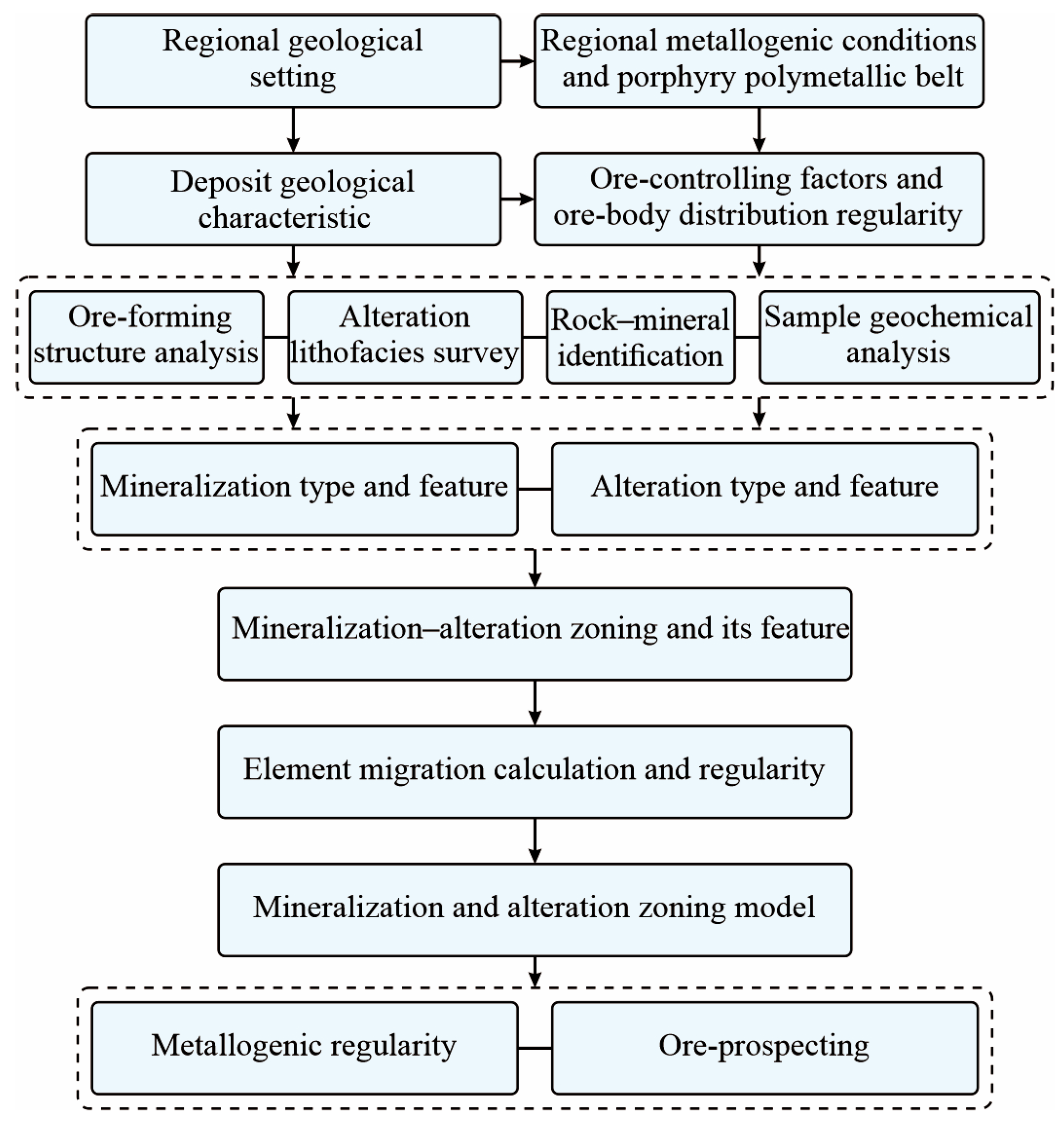
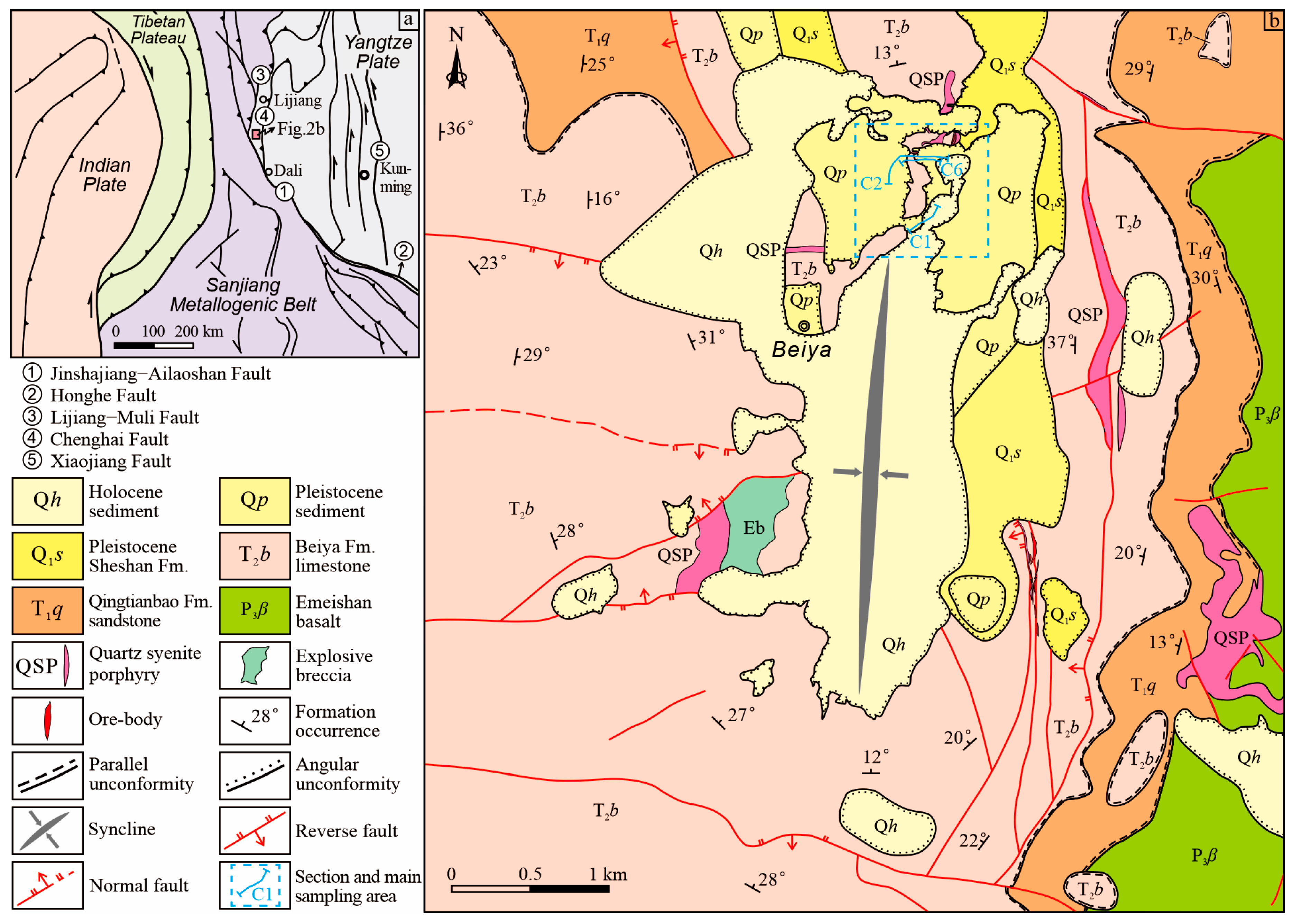

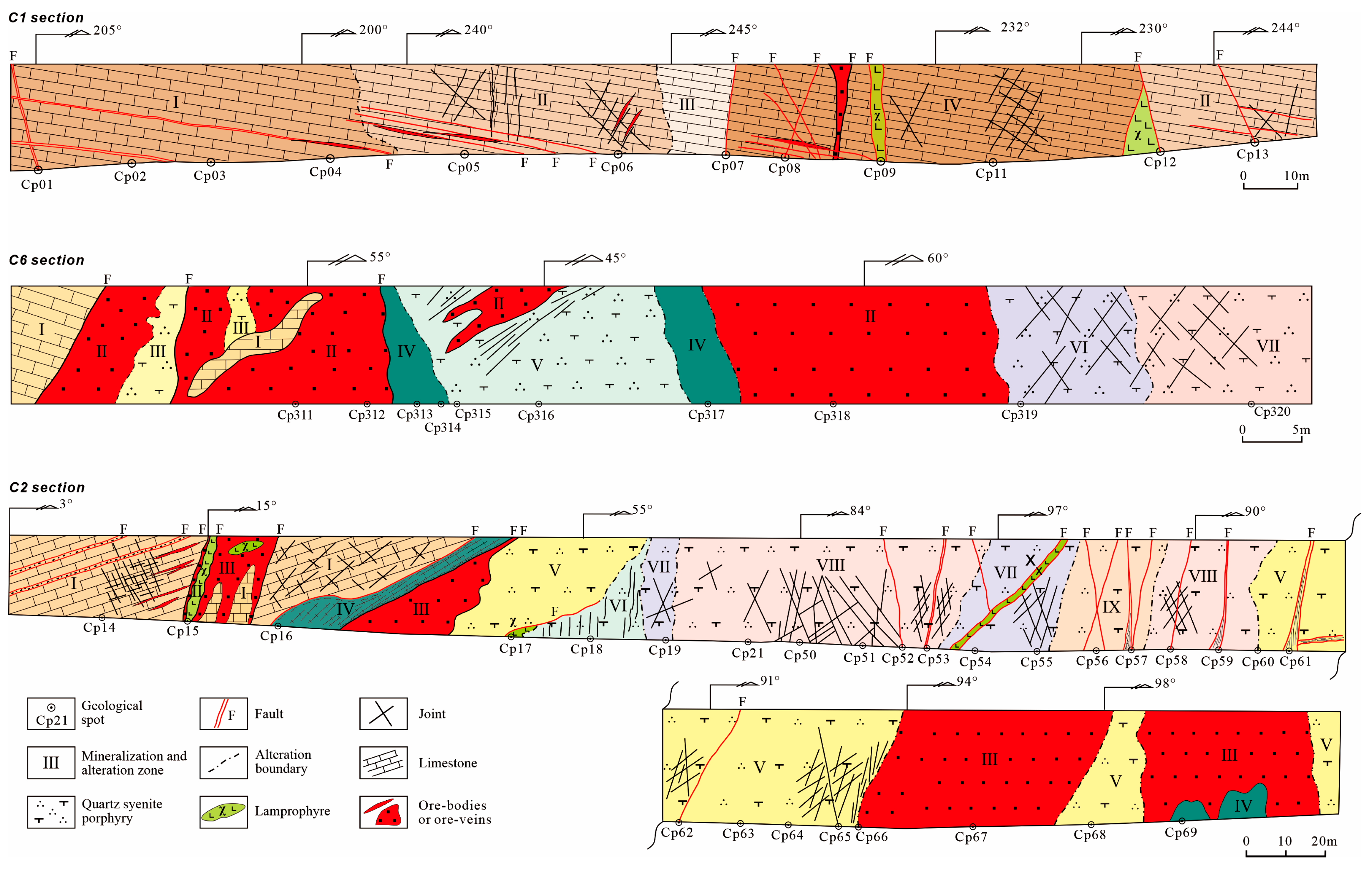
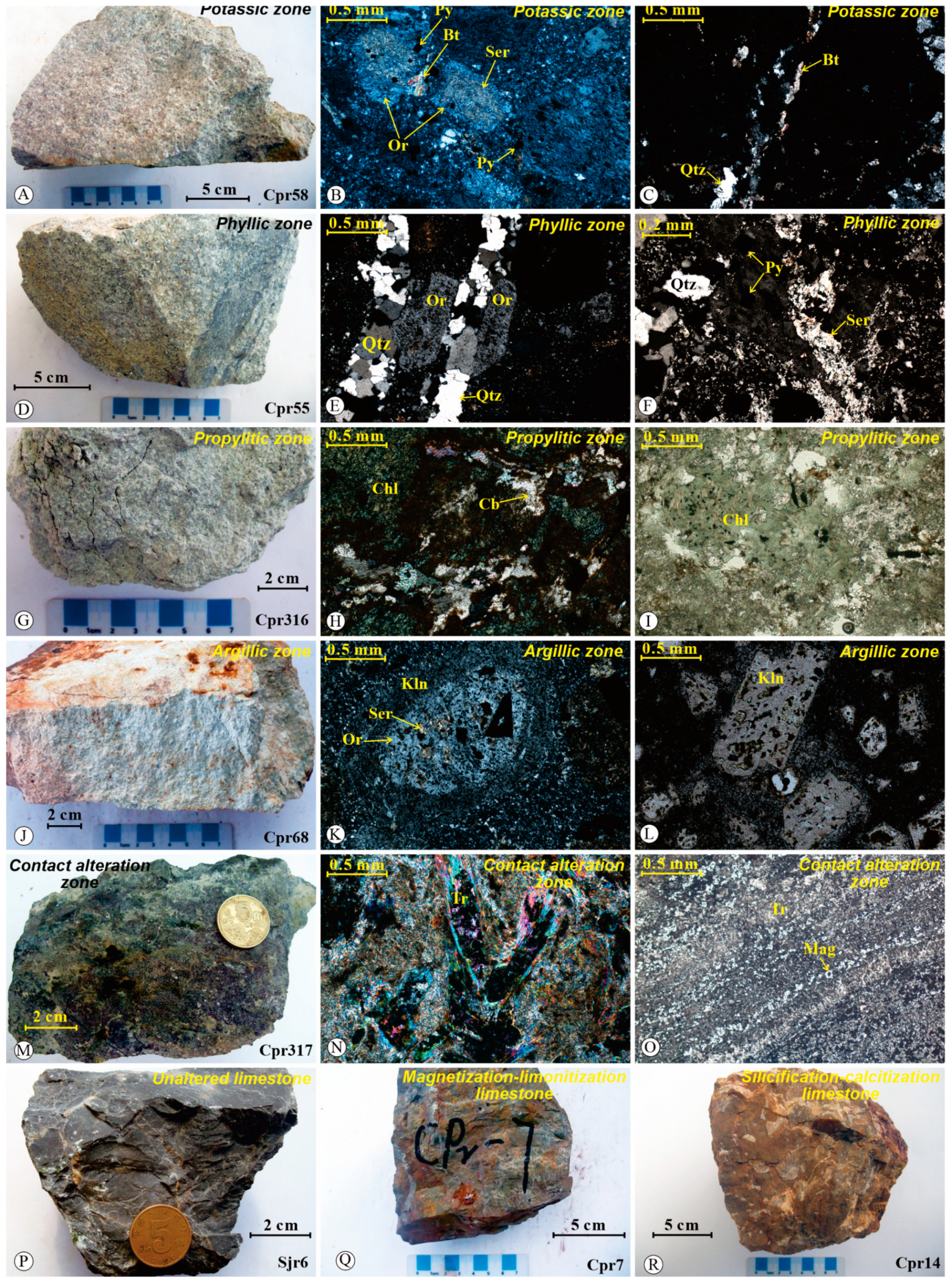
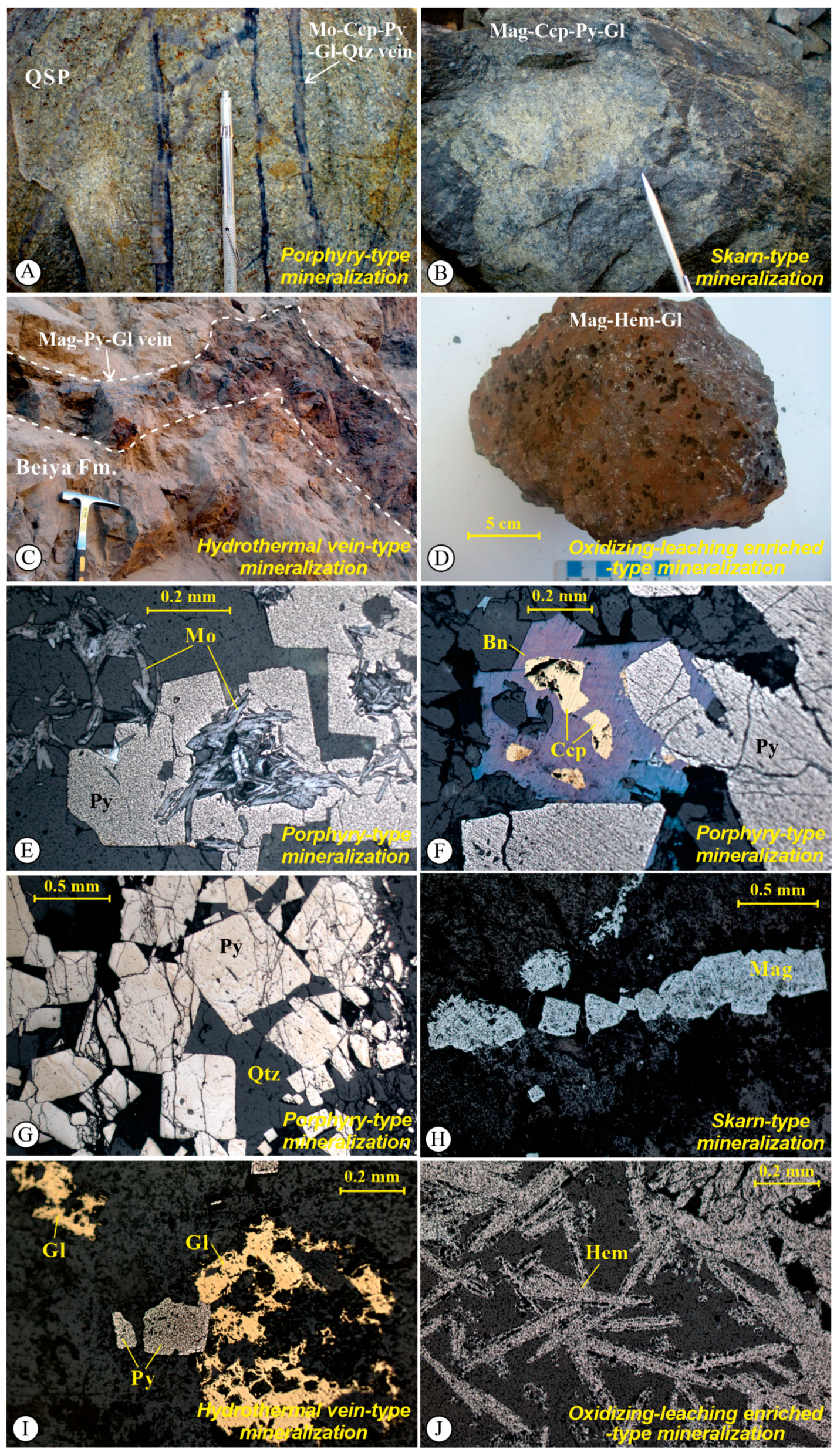
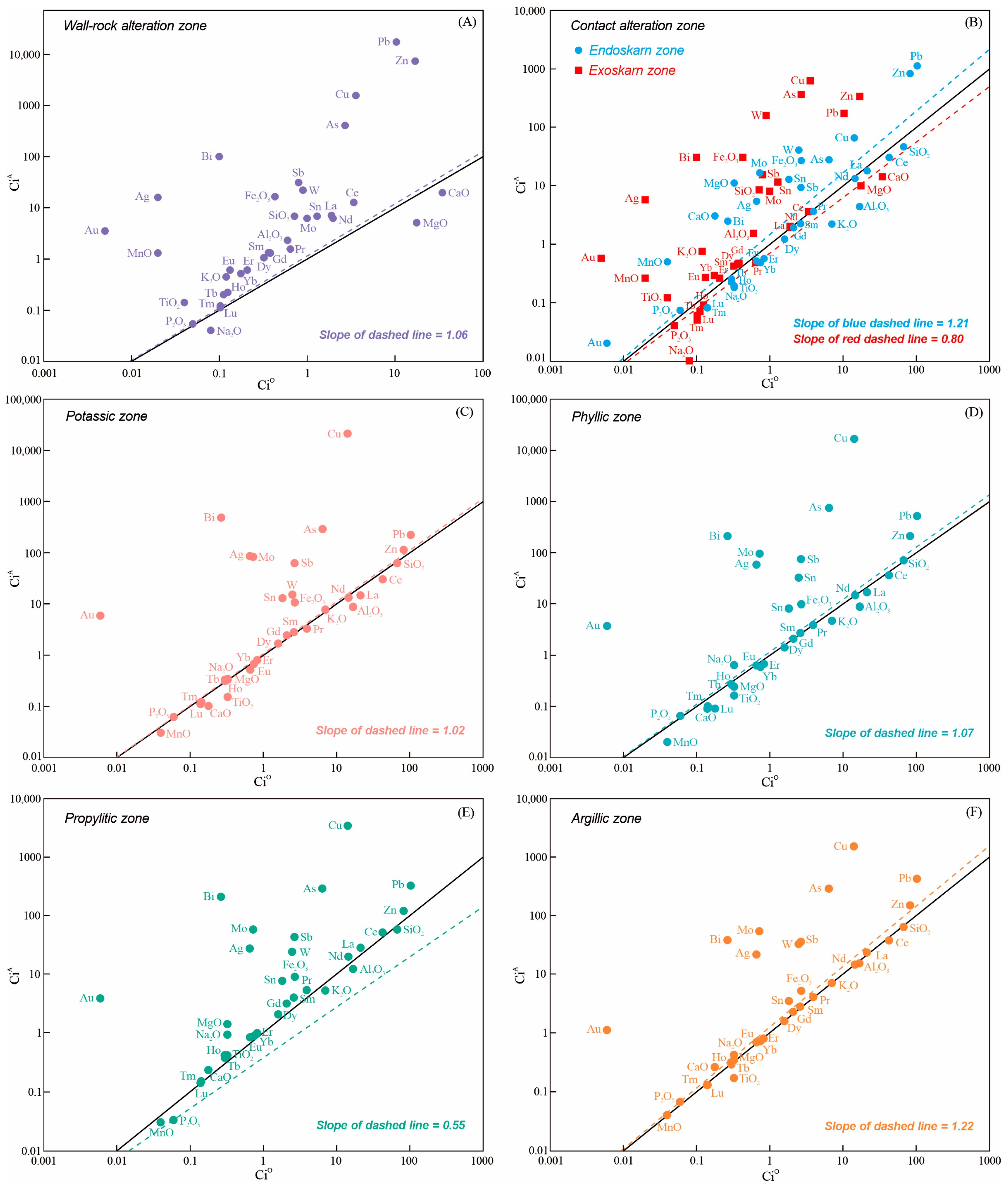
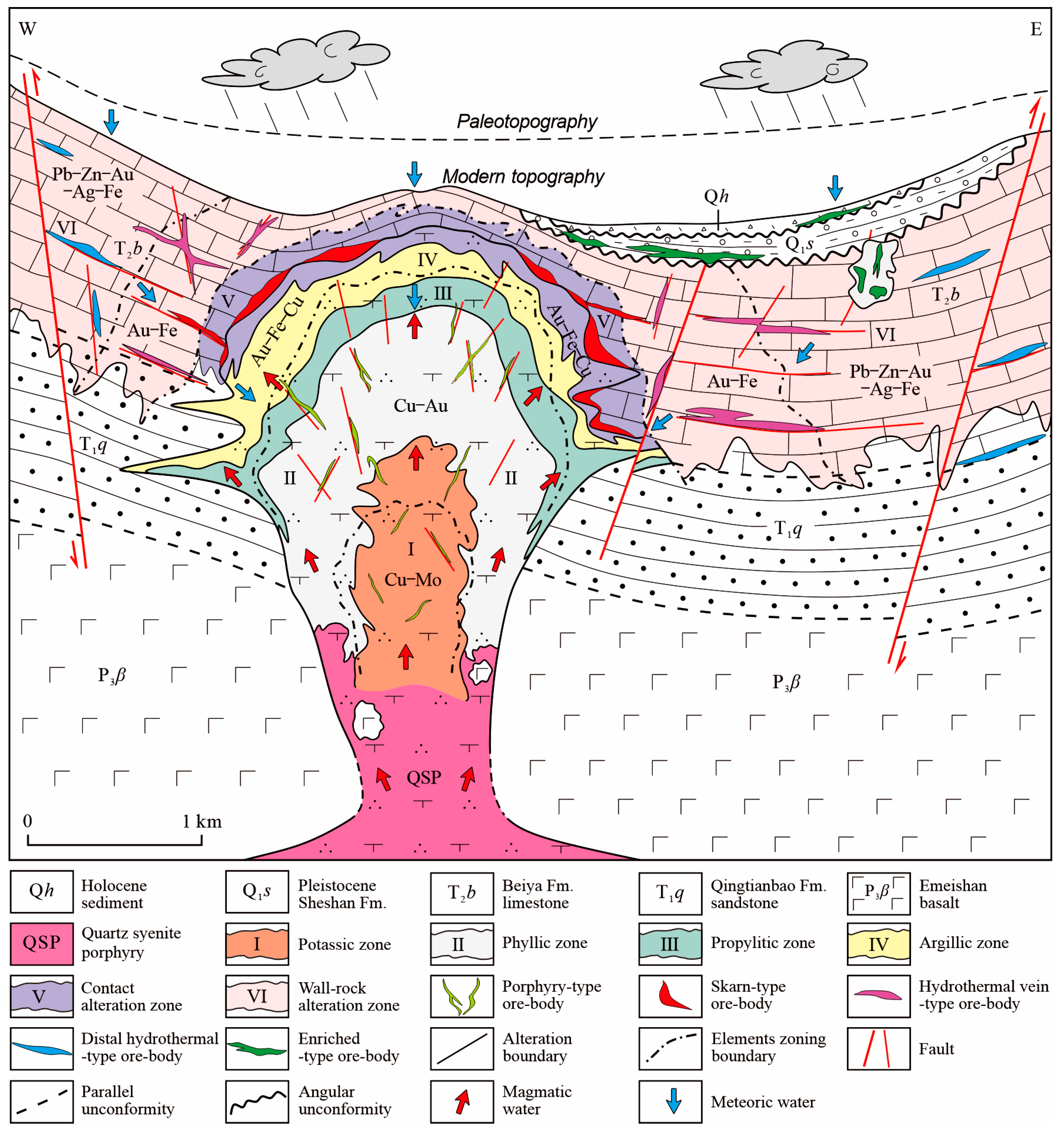
| Elements (10−6)/Oxides (wt.%) | Al2O3 | CaO | Fe2O3* | K2O | MgO | MnO | Na2O | P2O5 | SiO2 | TiO2 | W | Sn | Mo | Bi | Cu | Au | Ag | |
|---|---|---|---|---|---|---|---|---|---|---|---|---|---|---|---|---|---|---|
| UL (n = 6) | 0.60 | 34.64 | 0.43 | 0.12 | 17.67 | 0.02 | 0.08 | 0.050 | 0.72 | 0.04 | 0.90 | 1.30 | 1.00 | 0.10 | 3.60 | 0.01 | 0.02 | |
| AML (n = 14) | 2.29 | 19.50 | 16.21 | 0.44 | 5.02 | 1.28 | 0.04 | 0.053 | 6.79 | 0.20 | 21.69 | 6.80 | 6.17 | 99.32 | 1540.00 | 3.45 | 15.70 | |
| EXS (n = 2) | 1.53 | 14.10 | 30.24 | 0.75 | 9.92 | 0.26 | 0.01 | 0.040 | 8.48 | 0.12 | 158.50 | 11.50 | 8.04 | 30.40 | 615.00 | 0.57 | 5.73 | |
| UQSP (n = 3) | 16.98 | 0.18 | 2.70 | 7.11 | 0.33 | 0.04 | 0.33 | 0.060 | 67.78 | 0.33 | 2.50 | 1.83 | 0.73 | 0.27 | 14.27 | 0.01 | 0.66 | |
| PZ (n = 13) | 8.60 | 0.10 | 10.53 | 7.68 | 0.34 | 0.03 | 0.33 | 0.061 | 61.01 | 0.15 | 15.00 | 12.70 | 81.50 | 477.31 | 20,770.00 | 5.88 | 84.84 | |
| PLZ (n = 16) | 8.68 | 0.09 | 9.67 | 4.63 | 0.24 | 0.02 | 0.63 | 0.064 | 69.80 | 0.16 | 31.94 | 8.00 | 93.60 | 207.70 | 16,647.00 | 3.68 | 57.50 | |
| PTZ (n = 6) | 12.12 | 0.23 | 8.88 | 5.17 | 1.38 | 0.03 | 0.92 | 0.033 | 57.40 | 0.41 | 23.83 | 7.50 | 56.80 | 207.37 | 3394.00 | 3.82 | 26.82 | |
| AZ (n = 13) | 15.04 | 0.26 | 5.13 | 6.91 | 0.34 | 0.04 | 0.42 | 0.067 | 63.40 | 0.17 | 32.31 | 3.40 | 53.30 | 37.51 | 1497.00 | 1.10 | 21.22 | |
| ENS (n = 4) | 4.31 | 2.98 | 26.66 | 2.18 | 10.98 | 0.49 | 0.18 | 0.073 | 45.80 | 0.19 | 39.88 | 12.70 | 16.37 | 2.43 | 64.90 | 0.02 | 5.32 | |
| Elements (10−6)/Oxides (wt.%) | Pb | Zn | As | Sb | La | Ce | Pr | Nd | Sm | Eu | Gd | Tb | Dy | Ho | Er | Tm | Yb | Lu |
| UL (n = 6) | 10.40 | 17.00 | 2.70 | 0.80 | 1.90 | 3.40 | 0.64 | 1.97 | 0.36 | 0.13 | 0.38 | 0.11 | 0.32 | 0.12 | 0.21 | 0.10 | 0.18 | 0.10 |
| AML (n = 14) | 17,190.00 | 7234.00 | 400.00 | 30.59 | 7.00 | 12.60 | 1.53 | 6.10 | 1.32 | 0.60 | 1.29 | 0.20 | 1.05 | 0.22 | 0.60 | 0.12 | 0.51 | 0.11 |
| EXS (n = 2) | 172.15 | 335.00 | 361.00 | 15.20 | 2.00 | 3.60 | 0.48 | 1.95 | 0.45 | 0.27 | 0.47 | 0.07 | 0.42 | 0.09 | 0.26 | 0.05 | 0.29 | 0.06 |
| UQSP (n = 3) | 103.40 | 82.90 | 6.47 | 2.68 | 21.47 | 42.83 | 3.94 | 14.67 | 2.64 | 0.66 | 2.11 | 0.30 | 1.60 | 0.30 | 0.83 | 0.14 | 0.75 | 0.14 |
| PZ (n = 13) | 219.70 | 111.00 | 283.10 | 61.45 | 14.30 | 29.50 | 3.28 | 12.90 | 2.76 | 0.52 | 2.42 | 0.33 | 1.67 | 0.31 | 0.80 | 0.12 | 0.66 | 0.11 |
| PLZ (n = 16) | 514.00 | 209.00 | 745.00 | 73.80 | 16.70 | 35.50 | 3.84 | 14.40 | 2.69 | 0.62 | 2.07 | 0.27 | 1.40 | 0.26 | 0.67 | 0.10 | 0.58 | 0.09 |
| PTZ (n = 6) | 320.70 | 118.00 | 285.40 | 42.80 | 27.90 | 51.00 | 5.21 | 19.50 | 3.92 | 0.83 | 3.10 | 0.41 | 2.02 | 0.37 | 0.97 | 0.15 | 0.87 | 0.14 |
| AZ (n = 13) | 422.50 | 148.00 | 286.80 | 35.37 | 23.00 | 37.00 | 3.97 | 14.30 | 2.74 | 0.68 | 2.24 | 0.31 | 1.56 | 0.29 | 0.79 | 0.13 | 0.71 | 0.13 |
| ENS (n = 4) | 1110.00 | 814.00 | 27.20 | 9.22 | 17.80 | 29.90 | 3.58 | 13.00 | 2.22 | 0.51 | 1.88 | 0.25 | 1.21 | 0.22 | 0.56 | 0.08 | 0.48 | 0.08 |
| Sections | Sample No. | Mo | Cu | Au | Fe | Pb | Zn | Ag | Ratios of Element Association | ||
|---|---|---|---|---|---|---|---|---|---|---|---|
| Cu + Au/Cu + Mo | Au + Fe/Cu + Au | Pb + Zn + Ag/Au + Fe | |||||||||
| C1 | Cp01 | 3.49 | 381.00 | 0.06 | 3.74 | 2740.00 | 838.00 | 5.72 | 0.991 | 0.010 | 942.588 |
| Cp03 | 2.92 | 251.00 | 0.57 | 47.30 | 2710.00 | 101.00 | 26.50 | 0.991 | 0.190 | 59.273 | |
| Cp04 | 17.15 | 945.00 | 2.16 | 41.20 | 48,600.00 | 2390.00 | 40.70 | 0.984 | 0.046 | 1176.907 | |
| Cp05 | 5.70 | 524.00 | 0.68 | 12.35 | 3960.00 | 829.00 | 13.20 | 0.991 | 0.025 | 368.578 | |
| Cp07 | 6.66 | 1300.00 | 0.78 | 36.40 | 41,900.00 | 35,000.00 | 41.30 | 0.995 | 0.029 | 2069.427 | |
| Cp08-1 | 6.62 | 3740.00 | 2.67 | 40.10 | 34,300.00 | 15,000.00 | 23.10 | 0.999 | 0.011 | 1153.217 | |
| Cp08-2 | 4.86 | 1985.00 | 17.85 | 19.40 | 14,050.00 | 8440.00 | 17.30 | 1.006 | 0.019 | 604.223 | |
| Cp11 | 4.89 | 7630.00 | 16.00 | 41.80 | 27,600.00 | 3930.00 | 17.40 | 1.001 | 0.008 | 545.803 | |
| Cp13-1 | 10.45 | 914.00 | 2.35 | 17.95 | 7180.00 | 8260.00 | 12.30 | 0.991 | 0.022 | 761.197 | |
| Cp13-3 | 1.49 | 126.50 | 0.05 | 4.79 | 425.00 | 2980.00 | 6.67 | 0.989 | 0.038 | 704.599 | |
| mean value | 6.42 | 1779.70 | 4.32 | 26.50 | 18,346.50 | 7776.80 | 20.42 | 0.99 | 0.04 | 835.58 | |
| C2 | Cp14 | 2.17 | 29.50 | 0.01 | 0.55 | 214.00 | 204.00 | 0.52 | 0.932 | 0.019 | 752.734 |
| Cp15-1 | 28.50 | 180.50 | 0.02 | 2.61 | 673.00 | 670.00 | 2.80 | 0.864 | 0.015 | 510.934 | |
| Cp16-3 | 9.60 | 1040.00 | 0.09 | 5.32 | 256.00 | 592.00 | 7.99 | 0.991 | 0.005 | 158.311 | |
| Cp17-2 | 165.50 | 919.00 | 0.08 | 7.56 | 102.50 | 132.00 | 7.46 | 0.847 | 0.008 | 31.674 | |
| Cp18-2 | 94.70 | 9400.00 | 16.95 | 19.8 | 771.00 | 52.00 | 92.20 | 0.992 | 0.004 | 24.903 | |
| Cp21-2 | 64.60 | 27,400.00 | 7.88 | 23.4 | 1020.00 | 84.00 | 123.00 | 0.998 | 0.001 | 39.226 | |
| Cp50-3 | 236.00 | 9100.00 | 40.8.0 | 22.3 | 1310.00 | 96.00 | 550.00 | 0.979 | 0.007 | 30.998 | |
| Cp52 | 86.50 | 160,500.00 | 4.24 | 17.65 | 119.50 | 61.00 | 606.00 | 0.999 | 0.0001 | 35.930 | |
| Cp53-1 | 51.80 | 11,350.00 | 10.10 | 38.7 | 1350.00 | 169.00 | 129.00 | 0.996 | 0.004 | 33.770 | |
| Cp54-2 | 54.10 | 5320.00 | 4.53 | 14.4 | 233.00 | 256.00 | 42.20 | 0.991 | 0.004 | 28.061 | |
| Cp56-1 | 6.87 | 17,550.00 | 10.25 | 32.5 | 1860.00 | 26.00 | 58.60 | 1.000 | 0.002 | 45.488 | |
| Cp57-2 | 16.35 | 168,500.00 | 4.92 | 18.7 | 904.00 | 135.00 | 442.00 | 0.100 | 0.0001 | 62.701 | |
| Cp58-1 | 14.55 | 5650.00 | 19.25 | 23.7 | 1380.00 | 115.00 | 63.60 | 1.001 | 0.008 | 36.289 | |
| Cp59-2 | 70.20 | 26,400.00 | 46.60 | 45 | 787.00 | 436.00 | 285.00 | 0.999 | 0.003 | 16.463 | |
| Cp61-1 | 196.50 | 620.00 | 0.09 | 1.35 | 70.30 | 20.00 | 2.00 | 0.759 | 0.002 | 64.231 | |
| Cp62 | 49.10 | 1540.00 | 8.42 | 23.7 | 302.00 | 71.00 | 69.80 | 0.974 | 0.021 | 13.786 | |
| Cp63 | 115.5 | 907.00 | 6.67 | 22.5 | 2750.00 | 141.00 | 22.70 | 0.894 | 0.032 | 99.887 | |
| Cp65 | 143.00 | 2680.00 | 0.71 | 34.1 | 435.00 | 279.00 | 5.94 | 0.950 | 0.013 | 20.681 | |
| Cp66-1 | 482.00 | 2540.00 | 17.50 | 20.8 | 1570.00 | 176.00 | 98.40 | 0.846 | 0.015 | 48.157 | |
| Cp67 | 62.60 | 4330.00 | 0.17 | 46.20 | 5160.00 | 369.00 | 31.30 | 0.986 | 0.011 | 119.925 | |
| mean value | 93.00 | 21,712.00 | 9.00 | 20.00 | 1013.00 | 194.00 | 126.00 | 0.90 | 0.01 | 103.53 | |
| C6 | Cp311 | 10.45 | 937.00 | 0.21 | 50.00 | 1135.00 | 207.00 | 3.74 | 0.989 | 0.054 | 26.801 |
| Cp314 | 2.96 | 111.50 | 0.02 | 16.60 | 141.50 | 279.00 | 1.16 | 0.974 | 0.149 | 25.375 | |
| Cp315 | 7.92 | 89.70 | 0.01 | 12.20 | 213.00 | 377.00 | 0.91 | 0.919 | 0.136 | 48.384 | |
| Cp316 | 6.50 | 180.50 | 0.01 | 2.19 | 46.20 | 108.00 | 0.63 | 0.965 | 0.012 | 70.281 | |
| Cp317-1 | 55.7 | 46.30 | 0.02 | 23.30 | 31.80 | 637.00 | 0.56 | 0.454 | 0.503 | 28.708 | |
| Cp318-1 | 6.48 | 190.00 | 1.05 | 35.10 | 88.30 | 78.00 | 3.46 | 0.972 | 0.189 | 4.696 | |
| mean value | 15.00 | 259.20 | 0.20 | 23.20 | 276.00 | 281.00 | 1.70 | 0.88 | 0.17 | 34.04 | |
| Metallogenic System/Space | Ore-Controlling Structure | Mineralization and Alteration Type | Metallogenic Element Association | Mineralization Occurrence | |
|---|---|---|---|---|---|
| oxidizing-leaching metallogenic system | angular unconformity interface, paleo-karst cave | calcitization silicification limonitization | Au–(Fe) | capsule-like irregular-shaped | |
| porphyry metallogenic system | wall-rock (distal) | interlayer fracture zone, interlayer fault | silicification calcitization | Pb–Ag–Zn–(Au)–(Fe) | layered banded |
| wall-rock (proximal) | interlayer fault, fracture and joint | marbleization silicification calcitization pyritization magnetization | Au–Fe | vein lenticular | |
| contact zone | contact zone structure | marbleization skarnitization pyritization magnetization | Au–Fe–(Cu) | irregular-shaped | |
| porphyry | fault, fracture and joint, breccia pipe | potassic alteration phyllic alteration propylitic alteration argillic alteration | Cu–Au–(Mo) | stockwork veinlet | |
Disclaimer/Publisher’s Note: The statements, opinions and data contained in all publications are solely those of the individual author(s) and contributor(s) and not of MDPI and/or the editor(s). MDPI and/or the editor(s) disclaim responsibility for any injury to people or property resulting from any ideas, methods, instructions or products referred to in the content. |
© 2024 by the authors. Licensee MDPI, Basel, Switzerland. This article is an open access article distributed under the terms and conditions of the Creative Commons Attribution (CC BY) license (https://creativecommons.org/licenses/by/4.0/).
Share and Cite
Liu, F.; Han, R.; Guo, Y.; Wang, M.; Tan, W. Element Migration of Mineralization-Alteration Zones and Its Geological Implication in the Beiya Porphyry–Skarn Deposit, Northwestern Yunnan, China. Appl. Sci. 2024, 14, 9653. https://doi.org/10.3390/app14219653
Liu F, Han R, Guo Y, Wang M, Tan W. Element Migration of Mineralization-Alteration Zones and Its Geological Implication in the Beiya Porphyry–Skarn Deposit, Northwestern Yunnan, China. Applied Sciences. 2024; 14(21):9653. https://doi.org/10.3390/app14219653
Chicago/Turabian StyleLiu, Fei, Runsheng Han, Yuxinyue Guo, Mingzhi Wang, and Wei Tan. 2024. "Element Migration of Mineralization-Alteration Zones and Its Geological Implication in the Beiya Porphyry–Skarn Deposit, Northwestern Yunnan, China" Applied Sciences 14, no. 21: 9653. https://doi.org/10.3390/app14219653
APA StyleLiu, F., Han, R., Guo, Y., Wang, M., & Tan, W. (2024). Element Migration of Mineralization-Alteration Zones and Its Geological Implication in the Beiya Porphyry–Skarn Deposit, Northwestern Yunnan, China. Applied Sciences, 14(21), 9653. https://doi.org/10.3390/app14219653





